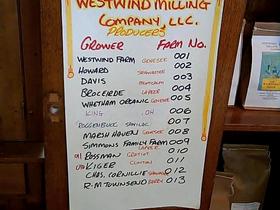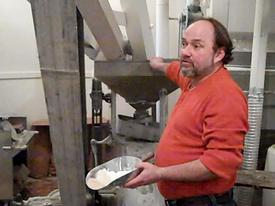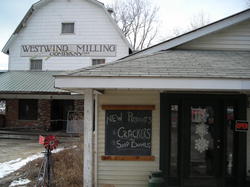Visit to Westwind Milling Company: our organic mill

Westwind Milling Company offers a variety of organic flours and mixes as well as freshly baked breads and cookies.
Corinna Borden | Contributor
For those of you who participated in the Local Table Passport hosted by the University of Michigan, Westwind Milling Company is already a familiar part of the locavore food scene in SouthEast Michigan.
Lee and Linda Purdy started out as organic farmers. As Lee Purdy explains, “We had been practicing organic farming since the 80s but not really utilizing the marketing part of it. Farmers are producers not marketers. And the old statistic is that 80 percent of the farmers sell to the lower third of the market. That was me. And a lot of other guys were doing the same thing. Because all they know about is producing. They were trying to produce large quantities, because that was the big rush during the 20th century - bigger bigger, cheap food, all that stuff. But it is like picking up a hot pan before you know where you are going to put it down.”

A partial list of the farms that supply the mill with grain.
Corinna Borden | Contributor
When grain is harvested, for example hard red spring wheat in early August, it is stored in bins until the second week of September to level the amount of moisture in the grains. As the autumn progresses, the stored grains become more consistent for baking uses because this equalizing has taken place. Purdy describes Kamut wheat, which was found stored in an Egyptian tomb and sprouted thousands of years later, as an example of the grain’s ability to store forever under the correct conditions. Only once the seed coat is broken does the grain begin to oxidize and lose nutrition.
This degradation of enzymes is why Westwind Millings Company’s “big thing is from wheat to bread in a day” when they are making their own baked goods. “We are concerned about losing nutrition. We feel that there are more enzymes in fresh flour.” Given their oven is 50 feet from the mill - that is an easy choice to make.

Lee Purdy describes the milling process.
Corinna Borden | Contributor
As Purdy explains, “Even though it is redundant, if I want to get grain to the other end of the building, I lift it and drop it and lift it and drop it till it gets to the right spot. It doesn’t matter because (the elevator legs) are running all of the time. When I am milling they are running, so I might as well utilize them.” The grain to be milled is kept on the second floor and is transported to the grinding stones via gravity. The entire machinery of the building is run on a 15-horsepower motor.
The grain is scoured, removing the tiny hairs from the kernel and broken seeds, before it is poured into the mill. Then the grain enters the mill where it is ground between the run stone and the bed stone. Then the meal and the flour are blown up and shifted, separating the unbleached flour from the wheat germ.
The Purdys' current project is to finish building a separate area for gluten-free milling. Linda Purdy is hopeful that, within two months, they will be up and running for a gluten-free mill. They will be adding certified organic gluten free buckwheat (which they currently grind, but there is a lot of gluten flour dust in the milling area), garbanzo and rice to their extensive list of offerings. They plan to offer amaranth and millet as well.

The mill is open Tuesday through Sunday. 8572 Silver Lake Road,
Linden, Mich.
Corinna Borden | Contributor

